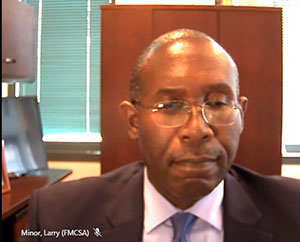Staff Reporter
Research Could Provide Window Into Driver Shortage

[Stay on top of transportation news: Get TTNews in your inbox.]
The aging trucker workforce and industrywide shortage of drivers present complex issues that could be explored with further research, according to a trucking safety committee.
The Federal Motor Carrier Safety Administration’s Motor Carrier Safety Advisory Committee met July 19-20 to discuss topics such as workforce issues and driver retention and listen to presentations from industry leaders.
Chartered in 2006, MCSAC advises FMCSA leaders on motor carrier safety programs and regulations. MCSAC’s 25 members represent safety enforcement officers, labor groups and trucking leaders.

Larry Minor by FMCSA MCSAC
Larry Minor, FMCSA’s associate administrator for policy, said the agency has reached out to industry representatives to learn about conditions that can make truck driving less appealing, such as detention time or weeks on the road. He mentioned a recent roundtable held July 8 between U.S. Department of Transportation officials and trucking industry groups that included a discussion on retention and apprenticeships.
“It was something to get the ball rolling and have a discussion with some key stakeholders,” Minor said. “There are all kinds of things that need to be considered.”
Prior to the session, FMCSA Deputy Administrator Meera Joshi made a brief introduction to the committee members and emphasized the importance of getting a good understanding of the industry’s “factual foundation.”
In terms of future research, Minor identified drivers with short-term medical cards as a subject area. Specifically, he said the agency is currently conducting research looking into what medical conditions these people are experiencing and if short-term medical card holders are overrepresented in crashes.
MCSAC member David Heller, vice president of government affairs for the Truckload Carriers Association, recommended using data collected from electronic logging devices, such as driver detention time and speed information, as a resource to better understand issues.
THE LIFESTYLE FACTOR: Turnover higher for over-the-road fleets
ACROSS THE POND: U.K. battles driver shortage too
“We have to have that consideration,” Heller said. “There’s so much information it can capture. We as an industry have to start paying attention to what that data is showing us.”
Besides identifying data points and their potential, participants discussed the factors that are contributing to the driver shortage in the first place.
According to American Trucking Associations, the trucking industry needed an additional 60,800 truckers in 2018, a shortfall that is expected to grow to 160,000 drivers by 2028 unless efforts to recruit more people improve.
Sid Mahant, owner of Mahant Transportation, said hours spent waiting for trailers to be loaded or unloaded is a concern that frequently comes up in the interviews his company conducts with drivers when they’re hired.
Also, Mahant suggested trucking companies pay visits to high schools to educate students on potential careers as truck drivers.
“That would make a real difference,” Mahant said.

Lamont Byrd by FMCSA MCSAC
Health challenges are another serious issue many truckers encounter, according to MCSAC Chairman LaMont Byrd, safety and health director for the International Brotherhood of Teamsters. He noted the Teamsters have an apprenticeship program with a module to educate young people about steps they can take to protect their health, such as reducing tobacco use and getting exercise.
A couple of committee members mentioned food options at truck stops have been diversified to include some healthier choices, but a driver pressed for time will likely choose a sandwich over a salad bar.
“Drivers are in a position where that’s all they really have time for,” said Todd Spencer, president of the Owner-Operator Independent Drivers Association. “With all of the focus on time, drivers are interested in: Get it and go. Quick.”
Byrd identified the availability of truck parking and the atmosphere of operating on congested roadways as other factors that can affect the job’s attractiveness.
“The road is largely the environment in which people work,” Byrd said. “You don’t control traffic; you don’t control weather.”
Want more news? Listen to today's daily briefing below or go here for more info:




